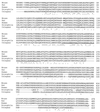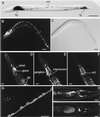The diabetes autoantigen ICA69 and its Caenorhabditis elegans homologue, ric-19, are conserved regulators of neuroendocrine secretion
- PMID: 11029035
- PMCID: PMC14991
- DOI: 10.1091/mbc.11.10.3277
The diabetes autoantigen ICA69 and its Caenorhabditis elegans homologue, ric-19, are conserved regulators of neuroendocrine secretion
Abstract
ICA69 is a diabetes autoantigen with no homologue of known function. Given that most diabetes autoantigens are associated with neuroendocrine secretory vesicles, we sought to determine if this is also the case for ICA69 and whether this protein participates in the process of neuroendocrine secretion. Western blot analysis of ICA69 tissue distribution in the mouse revealed a correlation between expression levels and secretory activity, with the highest expression levels in brain, pancreas, and stomach mucosa. Subcellular fractionation of mouse brain revealed that although most of the ICA69 pool is cytosolic and soluble, a subpopulation is membrane-bound and coenriched with synaptic vesicles. We used immunostaining in the HIT insulin-secreting beta-cell line to show that ICA69 localizes in a punctate manner distinct from the insulin granules, suggesting an association with the synaptic-like microvesicles found in these cells. To pursue functional studies on ICA69, we chose to use the model organism Caenorhabditis elegans, for which a homologue of ICA69 exists. We show that the promoter of the C. elegans ICA69 homologue is specifically expressed in all neurons and specialized secretory cells. A deletion mutant was isolated and found to exhibit resistance to the drug aldicarb (an inhibitor of acetylcholinesterase), suggesting defective neurotransmitter secretion in the mutant. On the basis of the aldicarb resistance phenotype, we named the gene ric-19 (resistance to inhibitors of cholinesterase-19). The resistance to aldicarb was rescued by introducing a ric-19 transgene into the ric-19 mutant background. This is the first study aimed at dissecting ICA69 function, and our results are consistent with the interpretation that ICA69/RIC-19 is an evolutionarily conserved cytosolic protein participating in the process of neuroendocrine secretion via association with certain secretory vesicles.
Figures








Similar articles
-
Islet cell autoantigen of 69 kDa is an arfaptin-related protein associated with the Golgi complex of insulinoma INS-1 cells.J Biol Chem. 2003 Jul 11;278(28):26166-73. doi: 10.1074/jbc.M213222200. Epub 2003 Apr 7. J Biol Chem. 2003. PMID: 12682071
-
Islet cell autoantigen 69 kD (ICA69). Molecular cloning and characterization of a novel diabetes-associated autoantigen.J Clin Invest. 1993 Jul;92(1):359-71. doi: 10.1172/JCI116574. J Clin Invest. 1993. PMID: 8326004 Free PMC article.
-
ICA69(null) nonobese diabetic mice develop diabetes, but resist disease acceleration by cyclophosphamide.J Immunol. 2002 Jan 1;168(1):475-82. doi: 10.4049/jimmunol.168.1.475. J Immunol. 2002. PMID: 11751995
-
Mammalian Unc-13 homologues as possible regulators of neurotransmitter release.Biochem Soc Trans. 1996 Aug;24(3):661-6. doi: 10.1042/bst0240661. Biochem Soc Trans. 1996. PMID: 8878822 Review. No abstract available.
-
Regulation of body fat in Caenorhabditis elegans.Annu Rev Physiol. 2015;77:161-78. doi: 10.1146/annurev-physiol-021014-071704. Epub 2014 Oct 20. Annu Rev Physiol. 2015. PMID: 25340962 Free PMC article. Review.
Cited by
-
The twisted pharynx phenotype in C. elegans.BMC Dev Biol. 2007 Jun 1;7:61. doi: 10.1186/1471-213X-7-61. BMC Dev Biol. 2007. PMID: 17540043 Free PMC article.
-
C. elegans ten-1 is synthetic lethal with mutations in cytoskeleton regulators, and enhances many axon guidance defective mutants.BMC Dev Biol. 2010 May 24;10:55. doi: 10.1186/1471-213X-10-55. BMC Dev Biol. 2010. PMID: 20497576 Free PMC article.
-
Islet-cell autoantigen 69 mediates the antihyperalgesic effects of electroacupuncture on inflammatory pain by regulating spinal glutamate receptor subunit 2 phosphorylation through protein interacting with C-kinase 1 in mice.Pain. 2019 Mar;160(3):712-723. doi: 10.1097/j.pain.0000000000001450. Pain. 2019. PMID: 30699097 Free PMC article.
-
Compromised central tolerance of ICA69 induces multiple organ autoimmunity.J Autoimmun. 2014 Sep;53:10-25. doi: 10.1016/j.jaut.2014.07.001. Epub 2014 Aug 1. J Autoimmun. 2014. PMID: 25088457 Free PMC article.
-
EAK-7 controls development and life span by regulating nuclear DAF-16/FoxO activity.Cell Metab. 2010 Jul 7;12(1):30-41. doi: 10.1016/j.cmet.2010.05.004. Cell Metab. 2010. PMID: 20620993 Free PMC article.
References
-
- Anderson GL. Responses of dauer larvae of Caenorhabditis elegans (Nematoda:Rhabditidae) to thermal stress and oxygen deprivation. Can J Zool. 1978;56:1786–1791.
-
- Avery L. Motor neuron M3 controls pharyngeal muscle relaxation timing in Caenorhabditis elegans. J Exp Biol. 1993;175:283–297. - PubMed
-
- Baekkeskov S, Aanstoot H, Christgau S, Reetz A, Solimena M, Cascalho M, Folli F, Richter-Olsen H, De Camilli P. Identification of the 64K autoantigen in insulin dependent diabetes as the GABA-synthesizing enzyme glutamic acid decarboxylase. Nature. 1990;347:151–156. - PubMed
-
- Bargmann CI, Harwieg E, Horvitz HR. Odorant-selective genes and neurons mediate olfaction in C. elegans. Cell. 1993;74:515–527. - PubMed
Publication types
MeSH terms
Substances
LinkOut - more resources
Full Text Sources
Molecular Biology Databases

